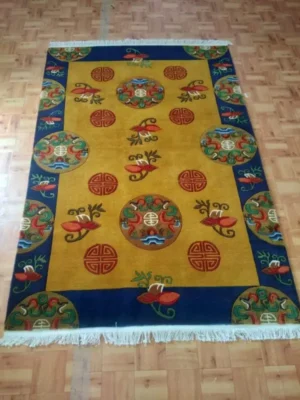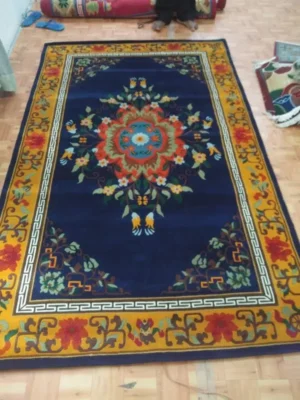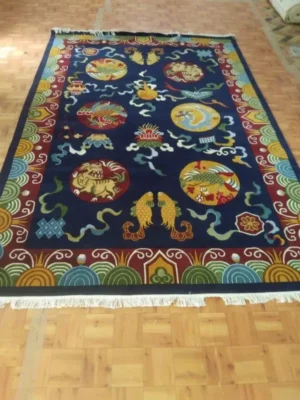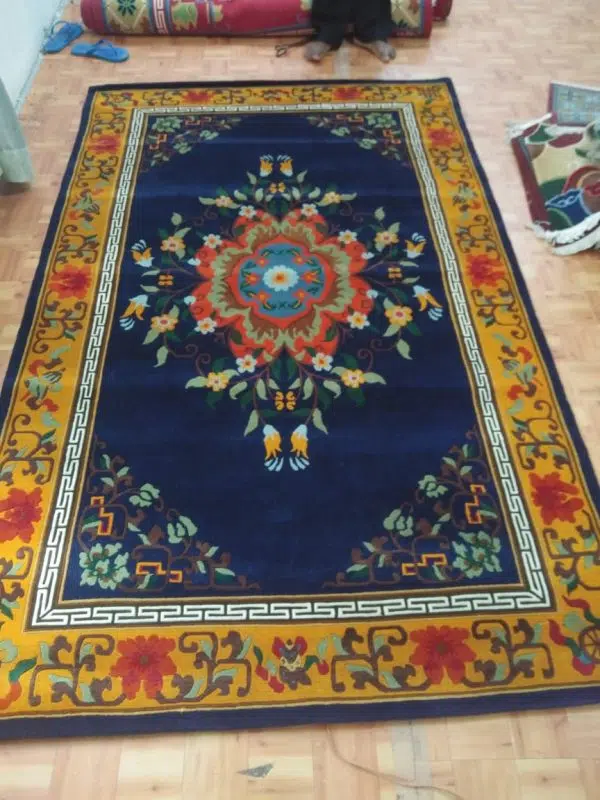Blog
Buddhist Symbol Rugs
![]()
Table of Contents
Complete Guide to Buddhist Symbol Rugs: A Deep Dive into Meaning, Craftsmanship, and Decor
Introduction to Buddhist Symbol Rugs
Buddhist symbol rugs are not just decorative pieces; they are deeply rooted in spiritual significance and cultural heritage. These rugs feature intricate designs inspired by Buddhist teachings, symbols, and motifs, often serving as a reminder of spiritual practices and principles. Crafted with meticulous attention to detail, Buddhist symbol rugs are a blend of artistry, tradition, and spirituality, making them a meaningful addition to any space.
This comprehensive guide will explore the various aspects of Buddhist symbol rugs, including their history, symbolism, craftsmanship, and how to incorporate them into your home decor.

The History and Origin of Buddhist Symbol Rugs
Buddhist symbol rugs have their origins in the rich traditions of Tibetan Buddhism. The art of rug-making in Tibet dates back centuries, with weavers creating rugs that reflected the spiritual and cultural values of the region. These rugs were often used in monasteries, temples, and homes as a way to bring sacred symbols into everyday life.
The symbols depicted on these rugs are often derived from ancient Buddhist texts and teachings. They serve as visual representations of concepts such as compassion, wisdom, and enlightenment. Over time, these rugs have become cherished for their spiritual significance, as well as their aesthetic beauty.
Also visit:-
Understanding the Symbolism in Buddhist Rugs
The symbols found on Buddhist rugs are rich with meaning, each carrying its own significance in the context of Buddhist teachings. Here are some of the most common symbols you may encounter on these rugs:
- The Eight Auspicious Symbols:
- The Parasol (Chatra): Symbolizing protection from harmful forces.
- The Two Golden Fish (Matsya): Representing the ability to swim freely, symbolizing happiness and freedom.
- The Treasure Vase (Kalasha): A symbol of spiritual and material abundance.
- The Lotus Flower (Padma): Representing purity and spiritual awakening.
- The Conch Shell (Shankha): Signifying the spread of the teachings of Dharma.
- The Endless Knot (Shrivatsa): Symbolizing the interconnectedness of all things and the cycle of life.
- The Victory Banner (Dhvaja): A symbol of the victory of wisdom over ignorance.
- The Wheel of Dharma (Dharmachakra): Representing the teachings of Buddha and the path to enlightenment.
- The Swastika:
- An ancient symbol of good fortune and well-being, the swastika is often found in Buddhist iconography.
- The Vajra:
- A symbol of indestructible truth and spiritual power, often associated with the thunderbolt.
- The Buddha Eyes (Wisdom Eyes):
- Often depicted on the spire of stupas, representing the all-seeing nature of Buddha.
Each of these symbols is carefully woven into the rug’s design, often combined with other decorative elements like floral patterns, geometric shapes, and traditional borders. Together, they create a rug that is not only beautiful but also deeply symbolic.

The Craftsmanship Behind Buddhist Symbol Rugs
The creation of a Buddhist symbol rug is a process that involves both artistic skill and spiritual intent. These rugs are typically handwoven by skilled artisans, often using traditional techniques passed down through generations. The materials used are often of the highest quality, including Tibetan wool, which is prized for its softness, durability, and natural sheen.
The Weaving Process:
- Designing: The process begins with the creation of a design, which is often based on traditional patterns and symbols. The design is carefully planned to ensure that the symbols are accurately represented and that the overall composition is harmonious.
- Dyeing: The wool is dyed using natural dyes derived from plants, minerals, and other organic sources. This not only ensures vibrant, lasting colors but also aligns with the Buddhist principle of living in harmony with nature.
- Weaving: The actual weaving process is done on a loom, with artisans meticulously knotting each thread by hand. This process can take months, depending on the size and complexity of the rug. The result is a rug that is both durable and rich in texture.
- Finishing: After the weaving is complete, the rug is carefully finished, which may include trimming the pile, washing, and stretching to ensure it lays flat.
The attention to detail in each of these steps ensures that every Buddhist symbol rug is a work of art, embodying the values and traditions of Tibetan craftsmanship.
Also visit:-
Incorporating Buddhist Symbol Rugs into Your Home Decor
Buddhist symbol rugs can be a powerful addition to any space, bringing both aesthetic beauty and spiritual depth. Here are some ideas on how to incorporate these rugs into your home decor:
- Living Room:
- Place a Buddhist symbol rug in your living room to create a focal point that draws attention and adds a sense of tranquility. The rich symbolism can serve as a conversation starter and a reminder of spiritual values.
- Meditation Space:
- Use a Buddhist symbol rug in a dedicated meditation area. The presence of sacred symbols can enhance the atmosphere, helping to create a serene and focused environment.
- Bedroom:
- A rug with calming symbols like the lotus flower or endless knot can bring a sense of peace and relaxation to the bedroom, promoting restful sleep.
- Hallway:
- A runner rug featuring Buddhist symbols can add an element of mindfulness to a frequently traveled space, subtly influencing the energy of your home.
- Home Office:
- Place a Buddhist symbol rug in your workspace to inspire clarity, focus, and a sense of purpose. Symbols like the Wheel of Dharma can remind you of the importance of wisdom and balance in your work.
When choosing a Buddhist symbol rug, consider the color scheme and size to ensure it complements your existing decor. The deep reds, blues, and golds often found in these rugs can add warmth and richness to a room, while the symbols themselves can introduce an element of spiritual reflection.

Caring for Your Buddhist Symbol Rug
Proper care is essential to maintaining the beauty and longevity of your Buddhist symbol rug. Here are some tips on how to care for your rug:
- Regular Vacuuming: Vacuum your rug regularly to remove dust and dirt. Be gentle to avoid damaging the fibers or pulling at the knots.
- Avoid Direct Sunlight: Prolonged exposure to direct sunlight can fade the colors of your rug. Try to place it in an area that receives indirect light, or use window treatments to protect it.
- Rotate the Rug: To ensure even wear, rotate your rug every few months. This helps to prevent one area from becoming more worn than others.
- Spot Cleaning: If a spill occurs, blot the area immediately with a clean, dry cloth. Avoid using harsh chemicals or soaking the rug, as this can damage the fibers.
- Professional Cleaning: For deep cleaning, it’s recommended to have your rug professionally cleaned by a specialist who understands the care required for handwoven rugs.
By following these care tips, you can preserve the beauty and integrity of your Buddhist symbol rug for years to come.
Conclusion: The Timeless Appeal of Buddhist Symbol Rugs
Buddhist symbol rugs are more than just decorative items; they are carriers of deep spiritual meaning and artistic tradition. Whether you are drawn to their beauty, their craftsmanship, or their symbolism, these rugs offer a unique way to bring the essence of Tibetan Buddhism into your home.
As you consider adding a Buddhist symbol rug to your space, remember that each rug is a reflection of the values and beliefs that have been cherished for centuries. It’s not just a piece of art for your floor—it’s a reminder of the spiritual path, a connection to cultural heritage, and a testament to the enduring craftsmanship of the artisans who create them.
Whether you choose a rug featuring the Eight Auspicious Symbols, the Lotus Flower, or the Endless Knot, you are bringing a piece of this rich tradition into your home, where it can inspire, uplift, and remind you of the deeper meanings in life.
Also visit:-
FAQs on Buddhist Symbol Rugs
1. What are Buddhist symbol rugs?
Buddhist symbol rugs are handwoven carpets that incorporate symbols from Buddhist teachings and iconography. These rugs often feature motifs such as the Eight Auspicious Symbols, the Endless Knot, and the Lotus Flower, which carry deep spiritual meanings in the context of Buddhism.
2. What is the significance of the symbols on Buddhist rugs?
Each symbol on a Buddhist rug has its own meaning, often rooted in Buddhist philosophy and teachings. For example, the Lotus Flower represents purity and spiritual awakening, while the Endless Knot symbolizes the interconnectedness of all things and the cycle of life.
3. Where do Buddhist symbol rugs originate?
Buddhist symbol rugs primarily originate from Tibet, Nepal, and other regions with a strong tradition of Tibetan Buddhism. These rugs have been woven for centuries, reflecting the spiritual and cultural heritage of these areas.
4. Are Buddhist symbol rugs handwoven?
Yes, most Buddhist symbol rugs are handwoven by skilled artisans using traditional techniques. This process involves intricate knotting, dyeing, and finishing, resulting in a high-quality, durable rug.
5. What materials are used in Buddhist symbol rugs?
Buddhist symbol rugs are typically made from high-quality materials such as Tibetan wool, silk, or a blend of both. Tibetan wool is particularly valued for its softness, durability, and natural sheen.
6. Can Buddhist symbol rugs be used in a home altar or meditation space?
Absolutely. Buddhist symbol rugs are ideal for use in meditation spaces, home altars, or any area where you wish to create a serene, spiritually-focused environment.
7. How do I care for a Buddhist symbol rug?
To care for your Buddhist symbol rug, vacuum it regularly, avoid direct sunlight to prevent fading, rotate it to ensure even wear, and clean spills immediately. For deep cleaning, it’s best to have it professionally cleaned by a specialist.
8. What are the Eight Auspicious Symbols commonly found on Buddhist rugs?
The Eight Auspicious Symbols include the Parasol (protection), the Two Golden Fish (freedom), the Treasure Vase (abundance), the Lotus Flower (purity), the Conch Shell (spread of Dharma), the Endless Knot (interconnectedness), the Victory Banner (wisdom over ignorance), and the Wheel of Dharma (teachings of Buddha).
9. What is the significance of the Endless Knot on Buddhist rugs?
The Endless Knot symbolizes the infinite cycle of life, the interconnectedness of all things, and the wisdom of Buddha. It is a powerful reminder of the spiritual path and the eternal nature of the universe.
10. Are Buddhist symbol rugs suitable for high-traffic areas?
Yes, Buddhist symbol rugs made from high-quality materials like Tibetan wool are durable and can withstand high-traffic areas. However, proper care and regular maintenance are essential to preserve their beauty and longevity.
11. Can Buddhist symbol rugs be custom-made?
Yes, many artisans offer custom-made Buddhist symbol rugs, allowing you to choose specific symbols, colors, and sizes to suit your personal preferences and space requirements.
12. How can I incorporate a Buddhist symbol rug into my home decor?
Buddhist symbol rugs can be incorporated into various spaces in your home, including the living room, bedroom, hallway, or meditation space. They add a touch of spiritual significance and aesthetic beauty to any room.
13. What is the meaning of the Lotus Flower on Buddhist symbol rug?
The Lotus Flower symbolizes purity, spiritual awakening, and enlightenment in Buddhism. It represents the journey of rising above difficulties and reaching a state of higher consciousness.
14. Do the colors used in Buddhist symbol rugs have specific meanings?
Yes, the colors in Buddhist symbol rugs often have symbolic meanings. For example, red represents power and energy, blue symbolizes wisdom and serenity, and gold signifies enlightenment and abundance.
15. Are Buddhist symbol rugs suitable for modern home decor?
Yes, Buddhist symbol rugs can complement modern home decor by adding a unique blend of spirituality, tradition, and artistic design. They work well with various interior styles, from contemporary to bohemian.
16. What is the Wheel of Dharma on Buddhist rug?
The Wheel of Dharma, or Dharmachakra, is a symbol representing the teachings of Buddha and the path to enlightenment. It is often depicted with eight spokes, symbolizing the Noble Eightfold Path.
17. How long does it take to create a Buddhist symbol rug?
The time required to create a Buddhist symbol rug depends on its size and complexity. Handwoven rugs can take several weeks to months to complete, as each knot is meticulously crafted by skilled artisans.
18. Can Buddhist symbol rugs be passed down as heirlooms?
Yes, due to their durable materials and timeless designs, Buddhist symbol rugs can be cherished as family heirlooms, passed down through generations as a symbol of spiritual heritage and tradition.
19. What makes Tibetan wool special for Buddhist symbol rug?
Tibetan wool is known for its exceptional quality, including softness, durability, and natural sheen. It is sourced from sheep raised in the high altitudes of the Tibetan Plateau, making it ideal for creating luxurious, long-lasting rugs.
20. Are there specific rituals associated with placing a Buddhist symbol rug?
While there are no specific rituals required, some people choose to bless the rug or place it with intentionality, especially if it is being used in a meditation or spiritual space.
21. Can Buddhist symbol rug be used in commercial spaces?
Yes, Buddhist symbol rug can be used in commercial spaces like yoga studios, wellness centers, and boutique hotels to create a calming and spiritually enriching environment.
22. What is the significance of the Conch Shell symbol on Buddhist rugs?
The Conch Shell represents the spread of Buddha’s teachings, the awakening of beings from ignorance, and the sound of Dharma that cuts through delusion.
23. How do I choose the right Buddhist symbol rug for my space?
When choosing a Buddhist symbol rug, consider the size of the space, the color scheme, and the specific symbols that resonate with you. It’s also important to ensure that the rug complements your existing decor.
24. Are there different styles of Buddhist symbol rug?
Yes, Buddhist symbol rugs come in various styles, ranging from traditional Tibetan designs to more contemporary interpretations. You can find rugs with intricate details or simpler, more minimalist patterns.
25. Can Buddhist symbol rugs be used as wall hangings?
Yes, due to their intricate designs and symbolic significance, Buddhist symbol rugs can also be used as wall hangings, adding a decorative and spiritual element to your home or meditation space.
Contact Us:-
ADDRESS
Loktantrik Chowk, Nakhipot-14, Lalitpur, Nepal
CONTACT HOURS
Sunday to Saturday 24/7
E-MAIL yuna.handicrafts@gmail.com
PHONE +977 9851-131344 (WhatsApp)



